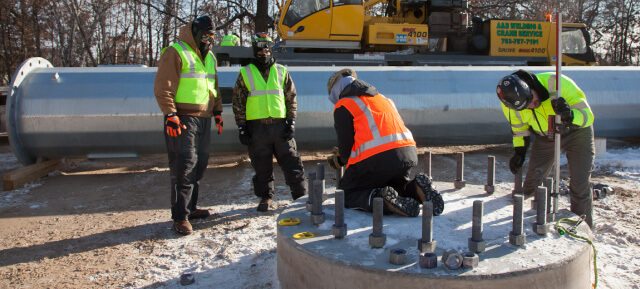
You can’t control winter weather, but you can control your crew’s winter shift scheduling to mitigate the side effects of working in a cold environment.
FREE DOWNLOAD: Talking points on working smarter in cold temps (more free downloads included at the bottom of this post)
Implement shorter shifts for increased productivity
Limiting exposure to the elements is crucial when it comes to preventing cold stress. Schedule shorter shifts to keep your crew fresh and productive, and when facing extremely cold weather, adjust work schedules and rotations accordingly. Additionally, scheduling shifts in the middle of sunny days allows you to take advantage of the sun’s heat.
Check out this sample cold weather work/rest schedule. (It helps determine the number and length of work breaks needed throughout a shift.)
How to use the work/rest schedule:
- Across the top row, locate the day’s predicted wind speed.
- Down the left side, locate the day’s predicted air temperature.
- Follow across and down to find the recommended work time and break time in a four-hour shift.
This scheduling tool helps reduce the physical demands of workers, increasing productivity and worker safety.
Be mindful of windchill
When considering the cause of cold stress, things like age, weight and fitness levels are factors. (Ergodyne talks more about recognizing hypothermia, frostbite and other common cold-related illnesses). There are also environmental factors, such as cold air temperatures, wind speed, air dampness and contact with cold surfaces. (Hence the importance of thermal work gloves. Watch this video.)
When the body is cold, it works harder to maintain its temperature, causing heat to be drawn from the body. The National Weather Service Windchill Temperature Index provides a useful formula for calculating the dangers of winter winds and freezing temperatures.
For example, when the air temperature is 40° Fahrenheit, and the wind speed is 35 mph, your exposed skin receives conditions equivalent to the air temperature being 28° Fahrenheit.
IMPORTANT NOTE: You can further fight windchill with Ergodyne N-FERNO® Warming Packs and N-FERNO® Full Face Stretch Caps.
Stay hydrated on the job site
It’s important to stay hydrated while working in cold weather, which tends to move body fluids from your extremities to your core, increasing your urine output and adding to dehydration.
 Perhaps you’re not sweating as much as you would in summer months, but you’re still losing moisture. You can literally see it leaving your body when temps hit freezing and your breath becomes visible. Additionally, a dehydrated body is more susceptible to common colds and flu, which are more prevalent in winter.
Perhaps you’re not sweating as much as you would in summer months, but you’re still losing moisture. You can literally see it leaving your body when temps hit freezing and your breath becomes visible. Additionally, a dehydrated body is more susceptible to common colds and flu, which are more prevalent in winter.
Cold stress and federal regulations
OSHA doesn’t have regulation around cold stress, and no states have adopted a cold stress standard. However, if there is a cold stress incident, states will turn to the General Duty Clause and issue citations based on those parameters.
“… pursuant to Section 5(a)(1) of the OSH Act, employers must provide their employees with a workplace free from recognized hazards likely to cause death or serious physical harm.” – General Duty Clause
Winter shift scheduling: Have a cold stress prevention plan
Every job site that involves exposure to winter-like conditions should have a cold stress prevention plan in place. Supervisors should know the signs of cold stress, as well as the proper response, and remind their workers of those during regular safety briefings. It’s also necessary to provide comprehensive cold stress training and a break area with heaters and windbreaks.
Other suggested administrative controls include:
- Enclose the work area.
- Remove snow and ice from heavily traveled areas such as parking lots and sidewalks.
- Schedule outdoor work in warmer months or at the warmest times of the day, and don’t schedule demanding work in extreme temps.
- Encourage your crews to wear insulated and waterproof footwear, and to keep a dry change of clothing with them.
More free downloads
Related posts
Thermal winter work gloves provide quality insulation in extreme cold